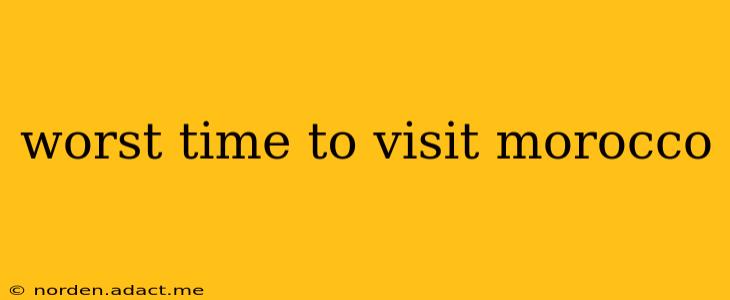Morocco, a land of vibrant culture, stunning landscapes, and rich history, offers a diverse travel experience. However, timing your visit is crucial for an optimal trip. While many months offer pleasant weather and fewer crowds, certain periods should be avoided. This guide explores the worst time to visit Morocco, focusing on factors like weather, crowds, and potential disruptions to your travel plans.
What Months Are Too Hot to Visit Morocco?
July and August are generally considered the worst months to visit Morocco, particularly for those sensitive to extreme heat. Temperatures soar across the country, reaching scorching levels, especially in the desert regions like Marrakech and the Sahara. This intense heat can make sightseeing uncomfortable and exhausting. While coastal areas offer some respite, the humidity can be oppressive.
Is It Ever Too Cold to Visit Morocco?
While Morocco doesn't experience truly freezing temperatures in most areas, December to February can bring chilly weather, especially in the mountainous regions and at higher altitudes. While daytime temperatures remain pleasant in many cities, evenings can be quite cool, and some mountain passes might even experience snow. This is less of a problem for those used to cooler climates but is something to consider if you prefer consistently warm weather.
When Are the Most Crowded Months in Morocco?
Morocco's tourism peaks during the shoulder seasons (April-May and September-October) and the summer months (June-August). This means you'll encounter more crowds at popular attractions, higher prices for accommodation, and a less tranquil atmosphere.
Are There Specific Events That Affect Travel?
While less common than peak seasons, certain events, like religious holidays and festivals, can impact your travel experience. These events can bring larger crowds and potentially affect the availability of accommodation or transportation. Researching any significant events coinciding with your planned travel dates is crucial.
What About Rainfall and Flooding?
Morocco's rainfall is largely concentrated between October and April. While this provides lush greenery in some areas, it can also lead to occasional flooding and disruption of travel, particularly in rural areas. The intensity and frequency of rainfall vary considerably from year to year, so it's essential to stay updated on weather forecasts closer to your travel date.
How Can I Find the Best Time to Visit Morocco for My Needs?
The "worst" time to visit Morocco is subjective and depends on your personal preferences and tolerance for heat, crowds, and potential weather disruptions. Consider these factors carefully when planning your trip:
- Your Heat Tolerance: If you dislike extreme heat, avoid July and August.
- Your Budget: Prices tend to be higher during peak season.
- Your Tolerance for Crowds: Shoulder seasons offer a good balance between pleasant weather and manageable crowds.
- Your Interest in Specific Activities: Some activities, such as hiking in the mountains, might be challenging during the coldest months.
By considering these factors and staying informed about current weather conditions and events, you can plan a trip to Morocco that aligns perfectly with your preferences and expectations. Remember to always check the most up-to-date information before you travel!
